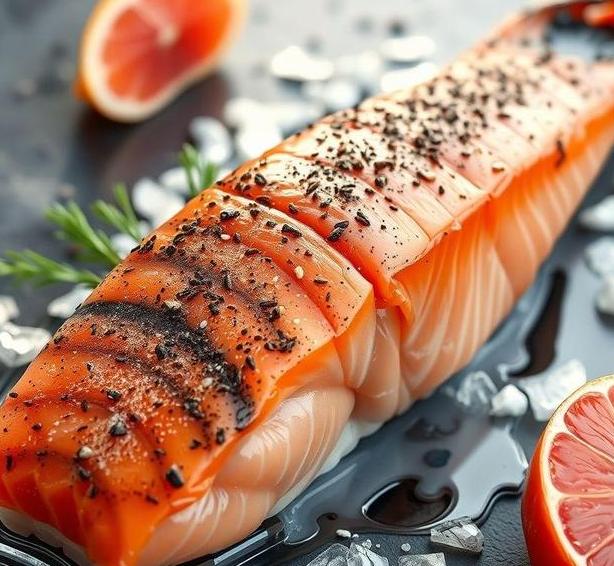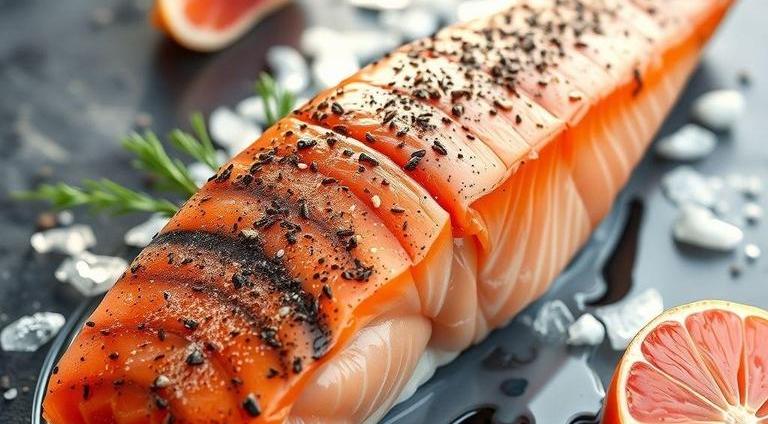Sushi-grade salmon is a term that immediately conjures images of beautifully sliced fish, delicately resting atop a bed of vinegared rice, or perhaps being dipped into a touch of soy sauce. Whether you’re a sushi enthusiast or a beginner just getting acquainted with the joys of fresh seafood, sushi-grade salmon holds a special place in the culinary world. But here’s a crucial question: Can sushi-grade salmon go bad?
The answer is, unfortunately, yes. Like any other type of fish, sushi-grade salmon is perishable and requires proper handling to maintain its freshness and quality. Knowing how to store it, how long it lasts, and the signs to watch out for when it’s gone bad are key to ensuring a safe and enjoyable sushi experience. Let’s dive into everything you need to know about sushi-grade salmon, from shelf life to spoilage signs and storage tips.
Can Sushi Grade Salmon Go Bad?
Absolutely, sushi-grade salmon can go bad. While the term "sushi-grade" is often used to indicate fish that is fresh enough to eat raw, it does not mean that it is immune to spoilage. Sushi-grade refers to the fish being frozen to a certain temperature to kill parasites, but after that, the clock starts ticking on how long the fish will remain safe to consume.
Here’s the thing: the term sushi-grade doesn’t guarantee that the fish will stay fresh forever-it simply means that the fish was handled and frozen properly to minimize the risk of parasites. However, without proper storage, bacteria can still develop, and the fish will deteriorate. So, sushi-grade salmon can go bad, just like any other raw fish, if it’s not kept in the right conditions.
Shelf Life For Sushi Grade Salmon

The shelf life of sushi-grade salmon largely depends on how it’s stored and the freshness of the fish when you purchase it. Here’s a breakdown of what to expect:
Common Signs Of Spoilage
It’s important to be aware of the signs that sushi-grade salmon has gone bad to avoid foodborne illness or an unpleasant dining experience. Here are the common spoilage indicators:
-
Off Smell
- Fresh sushi-grade salmon should have a clean, ocean-like scent. If you notice any sour, rancid, or overly fishy odor, it’s a clear sign that the salmon has started to spoil. Trust your nose on this one-if it smells bad, it likely is bad.
-
Discoloration
- Fresh salmon should have a vibrant, reddish-pink hue. If the fish turns an off-color, like brown or gray, it could mean it’s gone bad. A slight fading of the color is also a warning sign that the fish is not as fresh as it once was.
-
Slime Or Stickiness
- Salmon should feel moist, but not slimy. A sticky or excessively slippery texture on the surface is a sign that bacteria are beginning to break down the fish. This can indicate that it has been left out too long or stored improperly.
-
Soft Or Mushy Flesh
- Fresh sushi-grade salmon should have firm flesh. If you press lightly and the fish feels mushy or soft, it’s no longer safe to eat. The texture should hold up without falling apart too easily.
-
Unusual Taste
- If you taste a small piece of salmon and it tastes overly bitter or “off”, discard it immediately. A fresh piece of sushi-grade salmon should have a clean, delicate flavor, without any overwhelming fishiness.
How To Store Sushi Grade Salmon?

Storing sushi-grade salmon properly is essential to preserve its freshness and prevent spoilage. Here are some tips on how to store it for the best results:
-
Refrigerating
- Use a Clean, Airtight Container: After you purchase sushi-grade salmon, keep it in the original vacuum-sealed packaging if possible. If it’s been opened, transfer it to an airtight container to prevent exposure to air and moisture. You can also wrap it in plastic wrap and foil for extra protection.
- Temperature Matters: Your fridge should be set to a temperature of 32°F (0°C) to keep the salmon as fresh as possible. Store it in the coldest part of the fridge (usually at the back).
-
Freezing
- Wrap It Up: If you’re not planning to eat the salmon within a couple of days, freezing it is the best option. Wrap it tightly in plastic wrap, then place it in a vacuum-sealed bag or heavy-duty freezer bag. The less air exposure, the better.
- Label It: Be sure to label the fish with the date it was frozen so you can keep track of how long it’s been in the freezer. Frozen salmon is best consumed within 3-6 months.
- Thawing: To thaw frozen salmon, place it in the fridge overnight. Avoid thawing it on the counter or in warm water, as rapid temperature changes can cause the fish to deteriorate more quickly.
-
Handling
- Always handle sushi-grade salmon with clean hands or utensils to avoid introducing bacteria.
- When preparing the fish, be mindful of keeping it cold and only take out what you plan to use right away.
Expert Tips
To make sure you’re getting the freshest, safest sushi-grade salmon possible, follow these expert tips:
- Buy From a Reputable Source: Always buy sushi-grade salmon from a trusted supplier, ideally one with a high turnover rate for their fish. Freshness is critical, and you want to make sure the fish has been properly handled from catch to display.
- Know Your Supplier’s Freezing Process: Sushi-grade salmon should be flash-frozen at -4°F (-20°C) for at least 7 days, as this process kills harmful parasites. If you’re buying it from a fish market or store, ask them about their freezing methods.
- Inspect Upon Purchase: When you buy sushi-grade salmon, give it a quick inspection. The fish should be firm, moist, and have no noticeable signs of discoloration or odor.
- Use It Quickly: As tempting as it is to save it for later, sushi-grade salmon is best enjoyed fresh. Try to consume it within 24 hours of purchase for the best experience.
- Serve Cold, Not Frozen: When making sushi or sashimi, ensure the salmon has thawed and is at refrigerator temperature, not frozen, when serving. This enhances the texture and makes it more enjoyable to eat.
FAQs
How Long Does Sushi Grade Salmon Last In The Fridge?
Sushi grade salmon typically lasts 1 to 2 days when stored properly in the refrigerator. It’s essential to keep it at a temperature of 32°F (0°C) to maintain its freshness.
Can Sushi Grade Salmon Go Bad Even If It’s Stored In The Fridge?
Yes, sushi grade salmon can go bad in the fridge if not consumed within a short time. Although it is typically fresher than regular salmon, it still has a limited shelf life due to its raw nature.
How Can You Tell If Sushi Grade Salmon Has Gone Bad?
Signs that sushi grade salmon has gone bad include a sour or off smell, discoloration (such as a dull or grayish appearance), slimy texture, or a fishy odor that intensifies. Fresh salmon should have a clean, ocean-like scent.
Can You Freeze Sushi Grade Salmon To Extend Its Shelf Life?
Yes, you can freeze sushi grade salmon, but it should be done as soon as possible after purchase to ensure quality. Freezing can extend its shelf life for up to 1-2 months, but it may alter the texture once thawed.
Is Sushi Grade Salmon Safe To Eat If It’s Been Sitting In The Fridge For 3 Days?
It is generally not recommended to eat sushi grade salmon after 3 days in the fridge. Even if it appears fine, bacteria can develop, posing a risk for foodborne illness.
How Can I Store Sushi Grade Salmon Properly To Avoid It Going Bad?
To store sushi grade salmon, wrap it tightly in plastic wrap or wax paper, then place it in an airtight container or a resealable plastic bag. Keep it on a plate or shallow pan on the bottom shelf of your fridge where the temperature is most consistent.
Can Sushi Grade Salmon Go Bad If It’s Left At Room Temperature?
Yes, sushi grade salmon can go bad if left at room temperature for more than 2 hours. Raw fish is highly perishable, and leaving it out increases the risk of bacterial growth and spoilage.
What Should I Do If My Sushi Grade Salmon Smells Fishy?
If your sushi grade salmon smells overly fishy or sour, it is likely past its prime and should not be consumed. Fresh sushi grade salmon should have a mild, ocean-like scent rather than a strong fish odor.
Does Sushi Grade Salmon Go Bad Faster Than Regular Salmon?
Yes, sushi grade salmon tends to spoil faster than regular salmon because it is often fresher and lacks preservatives. It’s typically handled with minimal processing and should be consumed quickly to ensure safety.
Can Sushi Grade Salmon Be Eaten After It Turns Slightly Brown?
If sushi grade salmon turns brown, it may be a sign of oxidation or spoilage. While slight browning does not always mean it’s bad, it is a good idea to inspect it for other signs like texture and smell before consuming.